#tenjin ryu jujutsu
Link
FIGHTING TECHNIQUES ✅ How To Do SHIHO NAGE in a FIGHT 🤩‼️ Jujutsu, Jujitsu, Aikido, Aikijujutsu
#youtube#youtube shorts#soke anshu#anshu christa jacobson#budo ryu kai#budo ryu ninjutsu#ninja#ninjutsu#ninpo#bujutsu#budo#taijutsu#ninpo taijutsu#budo taijutsu#jujutsu#jujitsu#aikijujutsu#aikido#shiho nage#tenjin ryu jujutsu#martial arts#self defense
1 note
·
View note
Photo
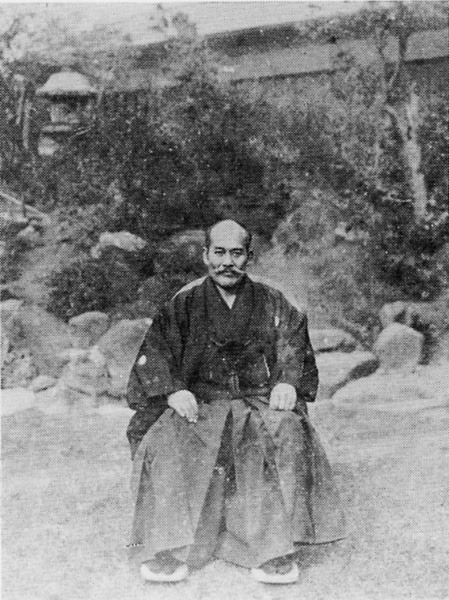
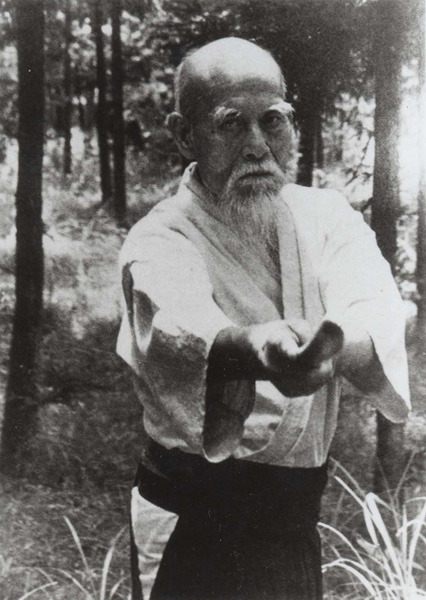

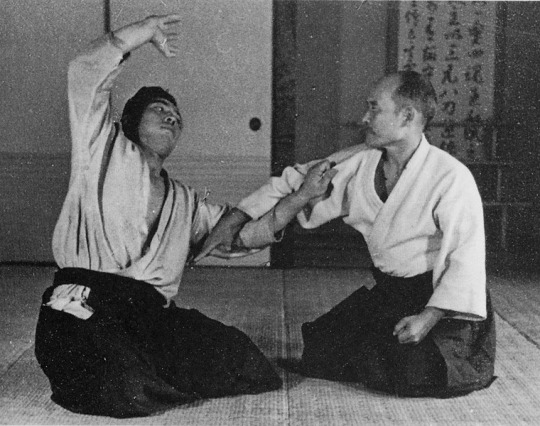
The Aikido founder. Born in Tanabe, Wakayama Prefecture, he studied Tenjin shinyo ryu and other ancient styles of jiu-jitsu at a young age.He met Takeda Sokaku,the Master Daito ryu Aiki jujutsu, and became his disciple.
After that, he opened a dojo in Tokyo and started spreading "Aikido".He taught Aikido energetically all over the country throughout his life, and became a respected by all Aikidoka. Passed away in 1969.
19 notes
·
View notes
Text
THE ORIGIN OF NAGE NO WAZA
THE ORIGIN OF NAGE NO WAZA
TENJIN SHINYO RYU JUJUTSU
View On WordPress
0 notes
Link
Martial Arts
A demonstration of classical Ju Jutsu from the annual Meiji Shrine martial arts celebration, in Tokyo. Take note of the approach, it's all close range and against grabs. Realise that much of this is based around preventing someone grabbing your sword or preventing someone from drawing theirs. Pointedly, there is little rolling around on the floor - thought of as the signature for Ju Jitsu these days.
Lastly something that even surprised me - kicking the guy when he's down ! Can't say I've seen this before in over classical Ju Jutsu style demonstrations.
#martial arts#japanese martial arts#martial arts history#ju jitsu#classical martial arts#traditional martial arts#Japan#meiji jingu#budoblr#budo#bujitsu
0 notes
Text
100 Years of Mastery: Golden Kamuy and Judo
Golden Kamuy digs deep into the history and culture of 1900s Japan, showing us life in snowy Hokkaido both in its growing cities and the Ainu's wilderness homes. We've learned all about Ainu food, survival techniques, and even the series' tense political climate--and while we're all wrapped up in the conspiracies and jagged alliances, it's easy to forget that Golden Kamuy is also a violent, rough-and-tumble action-adventure.
In fact, one thing that's surprised me from the get-go (but shouldn't have, really) is how much detail and thought is put into Golden Kamuy's martial arts, and how they and the series' action are informed by the state of martial arts in 1900s Japan. This is covered on multiple fronts with a variety of characters, but let's start with one of the best--Ushiyama the Undefeated and his judo!
Judo, meaning "the Gentle Way," was invented in 1882 by Jigoro Kano, a Tenjin Shin'yo-ryu jujutsu practitioner who was blessed with a great mind and technique but cursed with a small body. Seeking a way to defeat larger, stronger opponents, he collected throwing and submission techniques from multiple jujutsu schools that he later codified into the Go Kyo no Waza, or Five Sets of Techniques. These throws, chokes, armbars, and leg locks became the curriculum of a new fighting system--instead of being a list of physical techniques (jutsu), judo was intended to be an all-encompassing philosophy or way (do), separating it from its origins in jujutsu.
Judo places a heavy emphasis on randori, free practice that focuses on practical application of techniques. It's one thing to practice forms and imagine throwing a human body, and it's another to internalize judo's philosophy of "maximum efficiency, minimum effort." The idea of leverage and technique over strength meant that a judo practitioner would conserve energy and use the smartest possible technique at the right time, instead of muscling through techniques to force a submission or throw. This also means that like in jujutsu (and later aikido), a judo practitioner has to know how to fall, and how to safely receive techniques so their partner can practice with them.
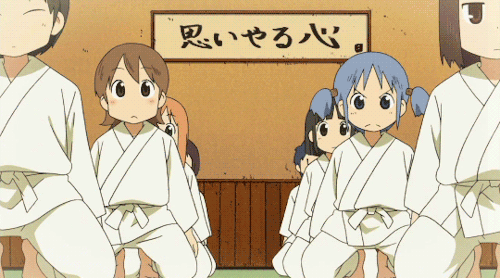
Not like this.
In the time Golden Kamuy takes place, judo is a refreshing new style, almost a fad, that combines the tradition and discipline of martial arts with the excitement and camaraderie of sports. With the Meiji Era's sword ban leading to the development of kendo, it was jujutsu's turn to evolve into a modern style, and competitive judo spread throughout Japan and further, with Kano visiting the United States and Europe. By 1900, changes were made to the competitive judo ruleset prohibiting certain joint locks to create a safer sport, and in 1911 it was inducted into Japan's educational system.
Today, judo is one of the world's most notable, popular martial sports, with schools across the globe. Judo has been an Olympic event since 1964, where it saw a resurgence in worldwide popularity--there was an even an episode of Happy Days where Arnold, played by Pat Morita, taught the kids judo. Martial arts themselves have come full-circle, with jujutsu going through yet another evolution to become Brazilian jiu-jitsu, leading to the modern definition of mixed martial arts. (For real, when you're done reading this go watch Fighting in the Age of Loneliness.)
In the 1964 Tokyo Olympics, Japan took Gold in the Light, Middle, and Heavyweight divisions, but the Netherlands' Anton Geesink took the Open Division Gold
Golden Kamuy mainly uses judo through Ushiyama the Undefeated, an escaped Abashiri convict who's been training for ten years without a single loss. The man already sounds like a monster on that alone, but then you can add the whole seducing-his-master's-wife-and-killing-his-master thing for flavor. Hell, when Shiraishi accidentally runs into him in episode 7, Ushiyama does (kind of an) okuri-ashi-harai on a horse:
And a real one for comparison--watch Hedvig Karakas in blue:
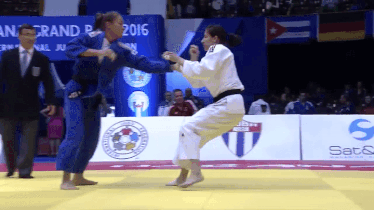
Episode 11 features Sugimoto's group running into Ushiyama again, and Sugimoto takes note of Ushiyama's ears--these are called cauliflower ears, and are a condition caused by blood clots (or other fluid) collecting in the ears' cartilage from blunt trauma. This is most common in combat sports (like judo!) or in contact sports where the ears are unprotected, like rugby.
Here's UFC legend Randy Couture's cauliflower ear, which got made fun of in The Expendables:
Moments after this, Ushiyama shakes Sugimoto's hand, and the two of them immediately get into a standing grapple, or kumi kate. Ideally, you're holding your opponent's sleeve with one hand and their lapel with the other. From here, you start trying to apply kuzushi, or unbalancing techniques, to get into a favorable position to perform a throw. Sugimoto notices that Ushiyama's center of gravity is incredibly low (he feels like it's "below the ground"), so trying to use a throw on Ushiyama would be super difficult and dangerous.
After a filling dinner and a lot of Sapporo beer, everything goes insane and Sugimoto actually has to fight Ushiyama the Undefeated back at the hotel. It's just as ludicrous and insurmountable a task as it sounds, but let's go through it technique-by-technique and watch Sugimoto totally almost die.
First things first: Ushiyama and Sugimoto lock up again, and Ushiyama just slams Sugimoto through a wall.
Sugimoto steps in and goes for what's probably judo's most recognizable technique, the shoulder throw called seoi nage.
And a real seoi nage for comparison:
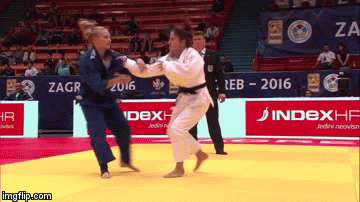
But Ushiyama, being the UNDEFEATED FREAK THAT HE IS, sticks his hand out in the middle of the throw to readjust his balance, and puts his feet up against (and through) the wall to prevent the throw.
And then... yeah, I can't really call this a judo technique as much as it's just the first half of a straight-up Power Bomb (but for the sake of this article, we'll say Ushiyama's doing a modified ushiro goshi, or back drop). Bye, Sugimoto.
To compare, here's a real ushiro goshi:
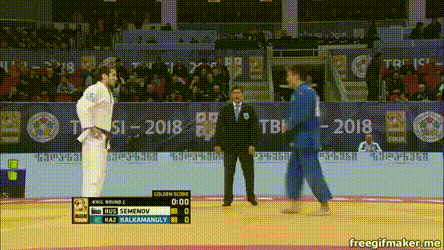
Sugimoto bravely tries to apply a juji gatame armbar on the still-not-fallen Ushiyama, but gets wrenched off the ground and slammed into the ceiling like he weighs nothing. Sugimoto then falls through a trapdoor and that brings this awesome fight to an end.
We don't see much of Ushiyama's judo until the second-season OP, where he does what looks like an uchimata (or a harai goshi?) on a freaking bear:

And then a real uchimata now:
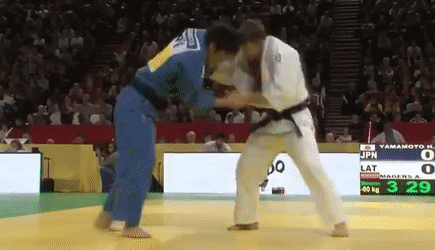
And while Ushiyama hasn't yet had as intricate a fight as the one in episode 11, in episode 21 we got to see an accurate depiction of the technique hadaka jime (aka a rear naked choke) by blind marksman Toni Anji. Notice how he's grabbing hold of his shirt to lock the choke, like how a jujutsu or judo practitioner would grab their gi.
While fighting Toni Anji, Sugimoto goes for another seoi nage, this time tucking his chin to try and drop Anji on his head. It's a very short sequence, but it's safe to say that Sugimoto's regular go-to technique is the seoi nage.
With season 2 of Golden Kamuy over, we're going to have to wait to see if there will be more judo on display. In the meantime, I'll be doing another article soon, this time talking about the history of karate and kenpo as used by the Japanese military, how it's portrayed in Golden Kamuy, and the history of kenjutsu and kendo, specifically Hijikata Toshizou's "Shinsengumi kenjutsu," reportedly derived from Kondo Isami's Tennen Rishin-ryu.
What have you found interesting in Golden Kamuy's martial arts? Have you ever trained in judo or jujutsu? You think you could take Ushiyama? Sound off in the comments and let us know!
-----
Nate Ming is the Features Editor for Crunchyroll News and creator of the long-running Fanart Friday column. You can follow him on Twitter at @NateMing. His martial arts webcomic, Shaw City Strikers, launches January 15, 2019.
0 notes
Photo

From the upper right to the left: Yamamoto Kunio (man's name). Saitama Bugei-cho (Directory of Martial Arts in Saitama). In red below (from the right): Sakakibara Kenkichi (a famous swordsman of the Kashima Shinden Jikishinkage-ryu kenjutsu). Iso Yoshito (perhaps read as Gichin, probably a leading exponent of Tenjin Shin'yo-ryu jujutsu). Source:http://sakitama-s.com/books/classification/history/entry_2203/ Thank's to Tobias Kiefl, Chris Covington, Daria Liko #jikishinkageryu #inazuma #kenjutsu #kashimashindenjikishinkageryu #naginata #naginatajutsu #koryu #sakakibarakenkichi https://www.instagram.com/p/Bo98Yubj_aD/?utm_source=ig_tumblr_share&igshid=nq7gcnkvkwen
#jikishinkageryu#inazuma#kenjutsu#kashimashindenjikishinkageryu#naginata#naginatajutsu#koryu#sakakibarakenkichi
0 notes
Text
Kurin Iaito (blunt edge) - Hiranami - by NineCircles
From the Shinto creation myths of Japan, through a myriad of legends of hideous sea monsters, to nationwide festivals giving thanks for the bounty of the ocean, the sea is intrinsically bound to Japanese culture and mythology.
The Hiranami model's Higo style hilt fittings depict a beautifully sculpted wave design, complemented by a flowing crescent Tsuba in blackend steel.
Kurin produce professional quality Iaido swords for the international market. The very purpose of an Iaito is to emulate a real sword as closely as possible, whilst eliminating the danger factor involved when practicing with a 'live' blade. These unique stainless steel Iaito fulfil that function to perfection.
Blade geometry, weight, balance, material flex and performance are all near identical to the high quality Shinken Kurin produce for advanced Iaido practice, making these Iaito the perfect option for Seitei and Koryu Iai practice.
These swords are strictly for use outside of Japan where the law proscribes the use of the superior stainless steel materials for the production of unregistered blades.
Features of these models include:
Iaido Blade - blades are slimmed down and have a full Hi to reduce overall weight and improve balance.
430 Stainless Steel - the ideal balance between strength and flexibilty, this tempered 430 stainless steel behaves near identically to the high carbon steel found in Kurin's production Shinken and is not at risk of stress factors sometimes seen in alloy Iaito blades.
Mirror Polish - a huge advantage over Japanese Iaito, these blades are polished to a mirror finish. This eliminates the risk of chrome fatigue and offers the chance to polish out damage caused by accidental contact with the floor or other blades.
Silver Kanagu - silver fittings in classic Japanese designs bring an additional touch of class to complete the package.
These swords do not include a stand.
The Kurin
stainless steel Iaito are a revolution in Iaito manufacture, combining the fluid grace and style of Japanese alloy Iaito, with the strength and durability of stainless steel. Very close in shape and feel to a Shinken (genuine sharp steel sword), but with a dulled edge for safe Iaido practice, these swords are great value for money and will last a lifetime of practice.
Aiki-Jujutsu and its Social Background
The next two and a half centuries (Tokugawa period) were relatively peaceful for Japan. Though they continued to practice, the Samurai as a class, saw little combat, and refined the various martial arts of Kenjutsu, Iai jutsu, Bajutsu, and forms of Jujutsu. Ju is a Chinese word meaning pliable, harmonious, adaptable or yielding, Jutsu means technique. As a collective term applied to all fighting forms, Jujutsu came into existence long after the forms it describes originated. Jujutsu's golden age extended from the late 17th century to the mid 19th century. As the martial arts and all Japanese culture became strongly influenced by Buddhist concepts, the fighting arts were transformed from combat techniques (Bugei) into ways (Budo), inculcating self-discipline, self-perfection and philosophy. The dimensions of the martial arts expanded beyond the simple objective of killing an enemy to include many aspects of everyday living. Particularly after the decline of the Samurai class, the martial techniques became martial ways and great emphasis was placed upon the study of Budo as a means of generating the moral strength necessary to build a strong and vital society. At the time, Aikido was known by many names, and remained an exclusively Samurai practice handed down within the Takeda family until Japan emerged from isolation in the Meiji period. The Meiji Revolution (1868) brought not only the return of Imperial supremacy, but also a westernised cultural, political and economic way of life to Japan. The Bushi, as a class, virtually disappeared under a new constitution that proclaimed all classes equal, but the essence of Bushido, cultivated for many centuries, continued to play an important part in the daily lives of the Japanese. Budo, being less combative and more concerned with spiritual discipline by which one elevates oneself mentally and physically, was more attractive to the common people of every social strata. Accordingly, Kenjutsu became Kendo, Iai jutsu became Iaido, Jojutsu became Jodo and Jujutsu became Judo. O-Sensei Morihei Ueshiba: The Founder of Modern Aikido As a young man, Morihei Ueshiba (born 14th December 1883) had an unusual interest in the martial arts, philosophy and religion. The environment of his youth, one of religious discipline and tradition, had an enormous effect on the course of his later life. In the year 1898, Ueshiba left his home village outside Osaka and travelled to Tokyo, seeking instruction in the martial arts. He actively investigated dozens of arts, but was eventually drawn to specialize in three: the sword style known as Yagyu Shin-Kageryu, the staff style known as Hozoin-ryu and Tenjin Shinyo Jujutsu. The Russo-Japanese War (1904) provided Ueshiba with a real situation to develop himself mentally and physically, in accord with the principles he had learned during his martial arts training. Ueshiba the soldier, spent most of the war years in the harsh climate of Northern Manchuria and by the end of the war, his health had deteriorated considerably. With characteristic vigour, he regained his vitality by the way of long hours spent in outdoor labour. Soon, Ueshiba was engaged by the government to lead a group of immigrants to Hokkaido (the Northern Island of Japan). Another adventurous young man also made the move to Hokkaido, his name was Sokaku Takeda, head of the Takeda family. Ueshiba and Takeda met in 1905 and Ueshiba began his study of Daito Ryu Aiki-Jujutsu under Takeda Sensei. In addition, he continued to practice the other arts he had learned in Tokyo, particularly Kenjutsu and Jojutsu.
#Aikido#Aikido Self Defence instruction#martial arts#japan#karate#weapons#MMA#Self Defence#Fitness#swords knives
0 notes
Photo

Jiu- Jitsu
El jiu-jitsu (柔術 jūjutsu, lit., «el arte suave») es un arte marcial japonés clásico o koryū budō que abarca una variedad amplia de sistemas de combate modernos basados en la defensa "sin armas" de uno o más agresores tanto armados como desarmados. Las técnicas básicas incluyen principalmente luxaciones articulares, y además golpes, patadas, rodillazos, esquivas, empujones, proyecciones, derribos, y estrangulamientos. Estas técnicas se originan en métodos de batalla de los bushi (guerreros japoneses clásicos), para hacer frente a otros guerreros samurai con armadura, (de ahí su énfasis en atacar con luxaciones, lanzamientos y estrangulaciones, más que fomentar el uso de golpes y patadas) estos se desarrollaron a lo largo de cerca de dos milenios.
El jiu-jitsu clásico además de la defensa sin armas, admite emplear otros objetos como armas defensivas u ofensivas, como pueden ser el abanico, el parasol, las cuerdas (Hojōjutsu), las monedas y las armas pequeñas de corte y contundentes, como jutte o tridente, tantō, kakushi buki (armas ocultas) e incluso kusarigama, ryofundo kusari o bankokuchoki, que resultan más elaboradas.
El jiu-jitsu era parte de sistemas más amplios llamados bujutsu, que incluía a su vez las principales armas largas del guerrero samurái de entonces: katana o sable, tachi o sable de caballería, yari o lanza, naginata o alabarda, jō o bastón medio y bō o bastón largo, entre muchísimas otras. Estos métodos de combate cuerpo a cuerpo eran parte importante de los distintos sistemas desarrollados para emplear en el campo de batalla y se pueden clasificar como katchu bujutsu o yoroi kumiuchi (combatir con o sin armas, vestido en armadura) de la era Sengoku (1467-1603) o suhada bujutsu de la era Edo (1603-1867) (combatir vistiendo a la usanza de la época, con kimono y hakama).
Estos sistemas de combates a mano limpia empezaron a conocerse como Nihon koryu jujutsu (jiu-jitsu japonés antiguo), entre otros términos, durante el período Muromachi (1333-1573), de acuerdo con los densho de varias escuelas o ryuha y a registros históricos.
Historia:
Teniendo en cuenta que uno de los impulsos más importantes de todo ser vivo es el de defenderse del ataque de depredadores o de individuos de la misma especie que compiten por territorio, comida o reproducción. A diferencia de los animales que disponen de mecanismos de defensa incorporados en su propia estructura, el ser humano adaptó aquello de que dispone para defenderse y desarrolla los métodos de defensa. Cuando algún método resulta eficaz, las otras personas lo copian o pretenden aprenderlo de quien lo desarrolló, con lo cual se formaliza no sólo la técnica, sino también los métodos de transmisión, esto dio el origen a las artes marciales del Japón.
Respecto a los orígenes del arte, hay una historia famosa sobre el guerrero Sekuni, de la provincia de Izumo, quien derrotó y dio muerte a Tajima no Kehaya en la prefectura de Shimane en presencia del Emperador Suinin. De acuerdo con descripciones, las técnicas utilizadas en éste enfrentamiento incluyeron golpes a puntos vitales, proyecciones, sometimientos o sumisiones y uso de armas tradicionales.
El jiu-jitsu probablemente se nutre de técnicas de lanzamiento, estrangulación, y luxación provenientes del Sumai, el antecesor del Sumo, y de los golpes a puntos vulnerables y vitales que bien podrían provenir del conocimiento marcial de refugiados chinos que durante los disturbios en China en el siglo XIII huían de la dinastía manchú y quienes traían consigo conocimientos de las formas de combate sin armas del kung fu / wu shu o Chuan-fa, y técnicas desarrolladas a lo largo del período feudal japonés por diferentes clanes a partir del combate en armadura o Kumiuchi.
Aunque al principio a cada uno de estas artes desarrolladas por individuos o clanes se le dio un nombre particular, luego fueron conocidos tanto en oriente como en occidente bajo la denominación común de Yawara o Jujutsu y a cada uno se le denominó “estilo” o “escuela” del arte genérico ryu-ha en japonés.
Históricamente, se asume que en algunas escuelas como la Kito Ryu, (escuela a partir de la cual se origina el Judo moderno junto con la escuela Shin'yō-ryū), hay una gran influencia del Shuai Shiao o lucha China, que incluye numerosas técnicas de derribos y lanzamientos, provenientes de las artes marciales de China. Sin embargo el fundador del Judo, el maestro Jigorō Kanō afirmó en una declaración realizada en 1888 durante los comienzos de la era Meiji en el Japón, (cuando Japón buscaba una mayor identidad al abrirse a occidente) que el Judo como tipo de lucha basado en los lanzamientos, las presas y derribos del Jiu-jitsu, era de origen específicamente Japonés; no Chino.
Es también claro, que en general los sistemas clásicos de jiu-jitsu/ Jujutsu dan mayor énfasis al trabajo en el suelo newaza, al entrenamiento en armas tradicionales, y además presentan técnicas mucho más japonesas como las llamadas idori o técnicas de control desde la posición arrodillado, o seiza (forma tradicional de sentarse erguido sobre las piernas dobladas bajo las caderas) así como técnicas shikko (desplazamiento de rodillas requerido de antaño en las visitas ante: el señor feudal o Daimyo, el líder militar Shogún o incluso ante el Emperador) que les son características. Además de las técnicas de desarme ante sable o "tachi waza", como arma esencial de los guerreros samurai.
Características Comunes:
Si bien existen diferencias en la apariencia y en las técnicas de varios sistemas de jiū-jitsu tradicionales, existen varias similitudes:
· Historias vinculadas y con origen en común en Japón donde con mucha frecuencia están relacionadas con alguna familia o clan.
· La principal forma de enseñanza es a través de la observación y repetición de las técnicas, muchas veces de acuerdo con patrones definidos en las llamadas katas (formas preestablecidas) en solitario o generalmente en parejas características de la escuela.
· Las técnicas incluyen golpes pero no como un fin en si mismos sino para facilitar llaves/ luxaciones a las articulaciones, lanzamientos, derribos o estrangulamientos.
· En general incluyen una base filosófica y ética a su práctica basada en el código del samurai o Bushidō.
· Tienen un sistema de grados basado en general en certificados de aptitud, donde a su vez se evalúa la actitud del practicante.
Artes marciales derivadas:
Algunas de sus descendientes directas son encontradas dentro del Gendai Budo estas son las artes marciales que fueron creadas en tiempos contemporáneos basadas en las escuelas antiguas. Como por ejemplo el Judo y el Aikidō que derivan de la síntesis de dos estilos de Koryu jiu-jitsu (Tenjin Shin'yō-ryū, y Kitō-ryū jiu-jitsu) el primero, y de la influencia del Daito-ryu Aikijujutsu en el segundo. Estas artes marciales fueron creadas posteriormente a la Restauración Meiji (inicios del siglo XX) con el respaldo y control del Dai Nihon Butokukai. Asimismo hay variantes y estilos desarrollados posteriormente en el siglo 20 como el Nihon Tai-Jitsu japonés; o el estilo marcial híbrido coreano del Hapkido. Es importante notar que tanto el jiu-jitsu como el judo han tenido una gran influencia en la inclusión o interpretación de varias técnicas como: las luxaciones articulares, estrangulaciones y algunos de los lanzamientos incluidas en los movimientos de los kata o formas de varias artes marciales tradicionales, especialmente en el caso de los estilos japoneses de karate-Do, ya que gran parte de los maestros japoneses difusores del karate, y muchos otros contemporáneos tuvieron, o mantienen aun contacto con el arte, debido a que fueron formados inicialmente en jiu-jitsu o en Judo.
Grados y cinturones:
En el Jiu-jitsu existen quince niveles distintos (llamados khan), según el grado de habilidad en dicha arte marcial. En Europa según el Departamento Español de Artes Marciales y Deportes de Contacto DEAMYDC, (Entidad reconocida por el Ministerio del Interior del Gobierno de España con número de inscripción 607327), así como son reconocidos por la Federación Española de Artes Marciales y Deportes de Contacto FEAMYDC.
En U.J.D. los colores de los cinturones ordenados de más inexperto a más experto son :
Grados inferiores.
· Cinturón blanco
· Cinturón blanco-amarillo
· Cinturón amarillo
· Cinturón amarillo-naranja
· Cinturón naranja
· Cinturón naranja-verde
· Cinturón verde
· Cinturón verde-azul
· Cinturón azul
· Cinturón azul-marrón
· Cinturón marrón
Grados superiores.
· 1º PUM cinturón Negro-rojo (negro infantil -15 años)
· 1º DAN - Negro(Sonseg-nim / Instructor)
· 2º PUM cinturón Negro-rojo (negro infantil -15 años)
· 2º DAN - Negro(Sonseg-nim / Profesor)
· 3º PUM cinturón Negro-rojo (negro infantil -15 años)
· 3º DAN - Negro(Sonseg-nim / Maestro)
· 4º DAN - Negro(Sabon / Maestro)
· 5º DAN - Negro(Sabon-nim / Gran Maestro)
· 6º DAN - Negro(Grado honorífico)
· 7º DAN - Negro(Grado honorífico)
· 8º DAN - Negro(Grado honorífico)
· 9º DAN - Negro (Grado honorífico Master)
El jiu- jitsu en Latinoamérica:
El jiu-jitsu en Argentina fue introducido por Yoshío Ogata, ayudante del Shihan Hagiwara de jiu-jitsu al que le ofrecen un contrato para enseñar jiu-jitsu a los oficiales de la Armada comenzando el 29 de noviembre de 1906. Posteriormente por intermedio del doctor Carlos Delcasse, una personalidad descollante y un famoso deportista que abre un gimnasio frecuentado por deportistas famosos de la época y gestiona el ingreso de Ogata a la policía de la ciudad de Buenos Aires, como instructor de defensa personal, en 1914 actúa como profesor de defensa personal en la Gendarmería Nacional de la Provincia de Neuquén y en 1918 comenzó a dictar clases en el Club Gimnasia y Esgrima de la ciudad de Buenos Aires, en 1938 continúa dictando clases de Ju-Jitsu en su propio Dojo llamado “Ausonia”, ubicado por calle Santa Fe y Montevideo en la Capital Federal hasta su fallecimiento el 1º de julio de 1970 en Buenos Aires, Argentina.
En Uruguay recién en 1958 Georges London llega de Francia fundando el instituto Shobukan donde enseña jiu-jitsu, judo y kárate, su alumno Sergio Omar Anadón Rivero continuo su obra en el país.
En Brasil se introduce en 1917, con la llegada a Brasil de Mitsuyo Maeda, profesor de Kodokan, que recibe el apoyo de un influyente político de nombre Gaston Gracie , Maeda empezó a enseñarle Judo al hijo mayor de Gastón, Carlos; en la ciudad de Belem quién luego enseñó a sus hermanos Oswaldo, Gastao, George y Helio. Los Gracies en 1925 viajaron a Río de Janeiro donde abrieron la primera academia de lo que pronunciaban como Jiu Jitsu y que con el tiempo ha alcanzado difusión mundial. Sin embargo para la comunidad japonesa en Brasil los maestros Naito Katsutoshi y Ogawa Tyuzo representaron la mayor influencia en el desarrollo del jiu-jitsu local.
En México En su libro "Siete migraciones japonesas en México (1890 - 1978)", María Elena Ota Mishima relata que en 1910 el jefe de los migrantes japoneses, Shinzo Harada al ser conocido como experto en Daito-Ryu Aiki jiu-jitsu fue llamado por el Secretario de Guerra y Marina y enseño en el colegio Militar durante 8 años a los cadetes entre los que se contaron los hijos de Don Porfirio Díaz. En 1926 otro profesor japonés (Nabutaka Sataka) es llevado a México por orden del General Plutarco Elías Calles a fin de dictar clases a las fuerzas militares y fue comisionado para enseñar también este arte marcial en la Escuela Nacional de Maestros (Normal), donde impartió sus conocimientos a los estudiantes de esa época.
En Cuba fue introducido en 1925 por el renshi Sigetoshi Morita y diez años después de su muerte se forma, en su honor la escuela Morita Ryu, Cuando se logra reavivar el Jiu Jitsu en la isla unos años más tarde se forman las escuelas Akijama Shirobei Ryu, Simón Ryu y Vamato Mijazawa que forman la base actual del Jiu Jitsu cubano. Con la revolución uno de los judokas que se integra al proceso es Andrés Kolychkine Thompson, nacido en Petrogrado el 11 de marzo de 1913 y casado con una cubana por lo que decide radicarse allí, sensei Kolychkine fue alumno de Jean De Herdt quien a su vez fue discípulo de sensei Mikonosuke Kawaishi, y desarrolló principalmente el judo cubano que influiría en el desarrollo de las artes marciales en todos los países de la región y que se mantiene actualmente.
En Costa Rica el jiu-jitsu comienza en 1955 año en el que el sensei Orlando Madrigal Valverde quién había aprendido con el profesor Kolychkine en Cuba. Instala la primera academia de judo y jiu-jitsu. Llamada academia costarricense de judo y jiu jitsu, el shihan costarricense muere lamentablemente el 25 de junio de 1991. Dejando un gran legado.
En Colombia el jiu-jitsu japonés llega aproximadamente entre los décadas de 1970 y 1980, pero su difusión y práctica en sí es más reciente (2003), el estilo tradicional se da a conocer, gracias a los esfuerzos de la Federación Colombiana de jiu-jitsu y a varias escuelas como: de la Riva Colombia, Team Pedro Sauer Colombia Academy, Gracie Barra, Team Legacy, Gracie Colombia, Alliance y Kanji de Lutas, quienes enseñan el Jiu-Jitsu brasilero.
En Chile El Soke Jorge Silva Figueroa (1980) crea y desarrolla el Método de Seguridad y Defensa Personal SINERG – JIUJUTSU, que es una versión del Jiujutsu clásico (particularmente del Aiki – Jiujutsu), interpretado como un método que aplica acciones sinérgicas y principios de ergonomía a partir de conductas instintivas y reacciones reflejas de auto protección ligadas a la movilidad natural.
AUTORES
Ricardo Nava CI: 28.020.121
Diego Nuñez CI: 26.750.326
Samir Rodriguez CI: 26.750.732
0 notes
Text
Ninjutsu...
The student that studies with the conscience of the divine, will be allowed to perceive the deepest secrets of the arts, as perception is a matter of perspective.
.
When learning the deepest secrets, one must walk down the path of Koden (古伝; Old Transmission), receive the Kuden (口伝; Verbal Transmission), understand the Hiden (秘伝; Secret Transmission), feel the Shinden (神伝; Divine Transmission) while studying the Densho (伝書; Written Transmission).
.
So just because someone has bought a scroll, or has a scroll, does not mean that they know the art or understand the secrets. The scrolls are just a physical symbol of the ryuha.
.
Here at the Budo Ryu Kai one has to dedicate themselves to the study of Ninjutsu and Bujutsu through the practice of the seven warrior traditions:
.
Koka Ryu Kempo (甲賀流拳法)
Tenjin Ryū Jujutsu (天神流柔術)
Tomo Ryu Shinobijutsu (戸猛流忍術)
Eishin-ryū Iaijutsu (英信流居合術)
Koto Ryu Koppojutsu (虎倒流骨法術)
Gyokko-Ryū Kosshijutsu (玉虎流骨指術)
Togakure-ryū Ninpo Taijutsu (戸隠流忍法体術)
.
Through the training of the nana musha-den, as well as the goho-no-keiko, one then starts to understand themselves and find their way through the understanding of Budo Ryu Ninjutsu.
1 note
·
View note
Video
youtube
Ground Fighting Defensive Training Drill | Jujutsu Martial Arts Techniques
#Martial Arts#Martial Arts Training#Self Defense#Self Defense Training#Ground Fighting#Ground Fighting Drills#Jujutsu#Jujutsu Drills#Jiu Jitsu#Jiu Jitsu Drills#Jujitsu#Jujitsu Drills#Grappling#Grappling Drills#Kumi Uchi#Tenjin Ryu#Tenjin Ryu Jujutsu#Krav Maga#Systema#Kung Fu#Wing Chun#Jeet Kune Do#Ninjutsu#Ninpo#Bujutsu#Budo#Kobujutsu#Kobudo#Kenpo#Kempo
14 notes
·
View notes
Video
youtube
The Art of Tenjin-ryu Jujutsu: True Traditional Budo Training | Martial Arts Fighting Techniques
#Soke Anshu#Anshu Christa Jacobson#Budo Ryu Kai#Budo Ryu Ninjutsu#Tenjin ryu Jujutsu#Jujutsu#Jujitsu#Jiu Jitsu#BJJ#Gracie Jiu jitsu#Ground Fighting#Grappling#Wrestling#Judo#Aikijujutsu#Aikido#Kenpo#Kempo#Karate#Karatedo#Self Defense#Self Defense Training#Self Defense Techniques#Ninja#Samurai#Martial Arts#Martial Arts Training#Ninjutsu#Ninpo#Bujutsu
1 note
·
View note
Photo

I want to congratulate a few of my personal students… . - Mr. Walters for achieving the rank of Shodan, 1st Degree Black Belt! . - Mr. Heath for achieving the rank of Nidan, 2nd Degree Black Belt! He also earned his Menkyo Shoden in Koka-ryu Kempo and Menkyo Shoden in Tenjin-ryu Jujutsu! . - Ms. Chantal Jacot for achieving the rank of Nidan, 2nd Degree Black Belt! She also earned her Menkyo Shoden in Koka-ryu Kempo and Menkyo Shoden in Tenjin-ryu Jujutsu! . I also want to thank Mr. Dupree & Mr. Gage! They were a HUGE help during testing! I dont know what I would have done if those 2 didn’t come and help! 🙏🏻 . JOIN THE ONLINE NINJUTSU DOJO! Study The Ancient Ninja Martial Art Called: “Ninjutsu”! 👺 ⛩ BudoRyuNinjutsu.com . Do you live in Kansas City? Call us for a FREE TRIAL CLASS! ☎️ (913) 449-5367 . Don’t Live in Kansas City? Join The Online Ninja Dojo! ⛩ BudoRyuNinjutsu.com . #KansasCity #MartialArts #Ninjutsu #Ninpo #Bujutsu #Budo #Kenpo #Kempo #Karate #Kenjutsu #Iaijutsu #Kobujutsu #Kobudo #Taijutsu #NinpoTaijutsu #Shinobijutsu #Jujutsu #JiuJitsu #SelfDefense #Goshinjutsu #TraditionalMartialArts #JapaneseMartialArts #BudoRyuKai #BudoRyuKai4Life #BudoRyuNinjutsu #SokeAnshu #AnshuChristaJacobson #Congrats #Congratulations #RankPromotion (at Kansas City, Kansas) https://www.instagram.com/p/CQWUWi6BQDq/?utm_medium=tumblr
#kansascity#martialarts#ninjutsu#ninpo#bujutsu#budo#kenpo#kempo#karate#kenjutsu#iaijutsu#kobujutsu#kobudo#taijutsu#ninpotaijutsu#shinobijutsu#jujutsu#jiujitsu#selfdefense#goshinjutsu#traditionalmartialarts#japanesemartialarts#budoryukai#budoryukai4life#budoryuninjutsu#sokeanshu#anshuchristajacobson#congrats#congratulations#rankpromotion
1 note
·
View note
Photo

Today is the last day of Black Belt testing for Mr. Walters, Mr. Heath and Ms. Jacot. As many of you know, Black Belt testing is a grueling 5-day test that directly correlates to the 5 areas of Ninjutsu training (Goho-no-Keiko). . - Mr. Walters is testing for Shodan (1st Degree Black Belt). - Mr. Heath is testing for Nidan (2nd Degree Black Belt) as well as Menkyo Shoden in Koka-ryu Kempo and Menkyo Shoden in Tenjin-ryu Jujutsu. - Ms. Jacot is testing for Nidan (2nd Degree Black Belt) as well as Menkyo Shoden in Koka-ryu Kempo and Menkyo Shoden in Tenjin-ryu Jujutsu. . All week long they have been under immense stress and pressure, and so far they have adapted, overcame and persevered through the all the challenges they’ve faced. Today is the last day and the most difficult day of the exam. It will be a test of strength, heart, endurance and warrior spirit. They will be faced with one of the most difficult physical challenges of their lives and regardless of what happens tonight, it has been an absolute honor training them in the arts. . JOIN THE ONLINE NINJUTSU DOJO! Study The Ancient Ninja Martial Art Called: “Ninjutsu”! 👺 ⛩ BudoRyuNinjutsu.com . Do you live in Kansas City? Call us for a FREE TRIAL CLASS! ☎️ (913) 449-5367 . Don’t Live in Kansas City? Join The Online Ninja Dojo! ⛩ BudoRyuNinjutsu.com . #Ninja #MartialArts #Ninjutsu #Ninpo #Bujutsu #Budo #Kobujutsu #Kobudo #Shinobi #Shinobijutsu #Taijutsu #NinpoTaijutsu #Kenpo #Kempo #Karate #Jujutsu #JiuJitsu #Kenjutsu #Iaijutsu #TraditionalMartialArts #JapaneseMartialArts #HistoricalNinjutsu #IgaRyuNinjutsu #KokaRyuNinjutsu #KogaRyuNinjutsu #BlackBelt #BlackBeltTesting #MartialArsTraining #MartialArtsLife #Warrior https://www.instagram.com/p/CQQ-H6kJu-P/?utm_medium=tumblr
#ninja#martialarts#ninjutsu#ninpo#bujutsu#budo#kobujutsu#kobudo#shinobi#shinobijutsu#taijutsu#ninpotaijutsu#kenpo#kempo#karate#jujutsu#jiujitsu#kenjutsu#iaijutsu#traditionalmartialarts#japanesemartialarts#historicalninjutsu#igaryuninjutsu#kokaryuninjutsu#kogaryuninjutsu#blackbelt#blackbelttesting#martialarstraining#martialartslife#warrior
1 note
·
View note
Video
youtube
2020 Tenjin-ryu Jujutsu Seminar | Samurai Grappling/Ground Fighting Training Techniques
#Soke Anshu#Anshu Christa Jacobson#Soke#Grandmaster#Budo Ryu Kai#Budo Ryu Ninjutsu#Ninja#Ninjutsu#Ninpo#Ninja Martial Arts#Ninjutsu Training#Ninjutsu Techniques#Ninjutsu Moves#Bujutsu#Budo#Kobujutsu#Kobudo#Koryu#Koryu Bujutsu#Jujutsu#Jiu Jitsu#Jujitsu#Ground Fighting#Grappling#Jujutsu Training#Jujutsu Techniques#Jujutsu Moves#Jujutsu Self Defense#Advanced Jujutsu#Jujutsu Basics
1 note
·
View note
Photo

Mr. Dupree | Sandan: Budo Ryu Ninjutsu 3rd Degree Ninjutsu Black Belt . I want to congratulate one of my personal students, Mr. Dupree on his 3rd Dan (3rd Degree Black Belt) Promotion! Congratulations! 🙏🏻 . Mr Dupree is my oldest active student. He’s been a student of the Budo Ryu Kai since 2007 and it’s been a true blessing working with him over the last 13+ years. . During this exam, Mr. Dupree also was awarded other koryu ranks, titles & scrolls outside of his 3rd Dan in Budo Ryu Ninjutsu. He was also awarded: . - Title of “Renshi” (Polished Master) - Menkyo Shoden Tomo-ryu Shinobijutsu - Menkyo Shoden Budo Ryu Ninjutsu - Menkyo Chuden Koka-ryu Kempo - Menkyo Chuden Tenjin-ryu Jujutsu . Also, as a reminder, Mr Dupree was the first student to be awarded the Jade Tiger Award, which is awarded to those who’ve trained 10 years within the Budo Ryu Kai. . The word samurai means: “to serve” and for over a 13+ years Mr. Dupree has dedicated himself to the study of authentic ninjutsu & samurai bujutsu. He is the man that no one ever sees or hears about, because he’s been the camera man for the dojo all these years... literally being the man behind the scene. . He is the one that helps others first with their materials, before he works on his own. He is the one that has attended every taikai, workshop and extra training event that I’ve ever held. He has been the rock that many overlook, yet so many have leaned on for help and support. If I only had one word to describe Mr. Dupree, it would be honor… . Words cannot express how proud I am of Mr. Dupree. It’s a true blessing having him as a student and a friend, and I look forward to many more years of training together. . #KansasCity #MartialArts #Ninjutsu #Ninpo #Bujutsu #Budo #Kenpo #Kempo #Karate #Kenjutsu #Iaijutsu #Kobujutsu #Kobudo #Taijutsu #NinpoTaijutsu #Shinobijutsu #Jujutsu #JiuJitsu #SelfDefense #Goshinjutsu #TraditionalMartialArts #JapaneseMartialArts #BudoRyuKai #BudoRyuKai4Life #BudoRyuNinjutsu #SokeAnshu #AnshuChristaJacobson #Congrats #Congratulations #RankPromotion (at Kansas City, Kansas) https://www.instagram.com/p/CBvkrSTJQKk/?igshid=1l0yb1rs0rlbo
#kansascity#martialarts#ninjutsu#ninpo#bujutsu#budo#kenpo#kempo#karate#kenjutsu#iaijutsu#kobujutsu#kobudo#taijutsu#ninpotaijutsu#shinobijutsu#jujutsu#jiujitsu#selfdefense#goshinjutsu#traditionalmartialarts#japanesemartialarts#budoryukai#budoryukai4life#budoryuninjutsu#sokeanshu#anshuchristajacobson#congrats#congratulations#rankpromotion
1 note
·
View note
Photo

Looking back at the last 10 years…
In 2010, Mr Dupree was a brown belt.
In 2020, Mr Dupree is preparing to test for his 3rd Degree Black Belt.
.
I’m going to be real, the last few weeks has been some rough training & Thursday night after class, I felt like I needed to give him a call & have a heart to heart about his test. I felt he was putting un-needed stress on the exam & I wanted to give him some words of encouragement.
.
Saturday morning, he came in for review & he dominated! It was VERY clear he’s been preparing for his upcoming exam!
.
Mr Dupree has been here over 13+ years, longer than any active student. He’s been with me through the ups and downs & he’s not waiverd in his unquestioned loyalty.
.
It’s been an honor working with him in the arts & I’m looking forward to seeing him in action in 2 weeks.
.
Study The Ancient Ninja Martial Art Called:
“Ninjutsu”! 👺
.
Do you live in Kansas City?
Call us for a FREE TRIAL CLASS!
☎️ (913) 449-5367
.
Don’t Live in Kansas City?
Join The Online Ninja Dojo!
⛩ BudoRyuNinjutsu.com
.
#SokeAnshu #KansasCity #MartialArts #Ninjutsu #Ninpo #Bujutsu #Budo #Kobujutsu #Kobudo #Shinobi #Shinobijutsu #Kenpo #Kempo #Karate #Karatedo #Kenjutsu #Iaijutsu #Taijutsu #Jujutsu #JiuJitsu #NinpoTaijutsu #SelfDefense #IgaRyuNinjutsu #KokaRyuNinjutsu #KogaRyuNinjutsu #TomoRyu #TomoRyuShinobijutsu #HistoricalNinjutsu #TraditionalMartialArts #JapaneseMartialArts (at Kansas City, Kansas)
https://www.instagram.com/p/CBJaLcBJapu/?igshid=r01w5fgvqv7p
#sokeanshu#kansascity#martialarts#ninjutsu#ninpo#bujutsu#budo#kobujutsu#kobudo#shinobi#shinobijutsu#kenpo#kempo#karate#karatedo#kenjutsu#iaijutsu#taijutsu#jujutsu#jiujitsu#ninpotaijutsu#selfdefense#igaryuninjutsu#kokaryuninjutsu#kogaryuninjutsu#tomoryu#tomoryushinobijutsu#historicalninjutsu#traditionalmartialarts#japanesemartialarts
1 note
·
View note